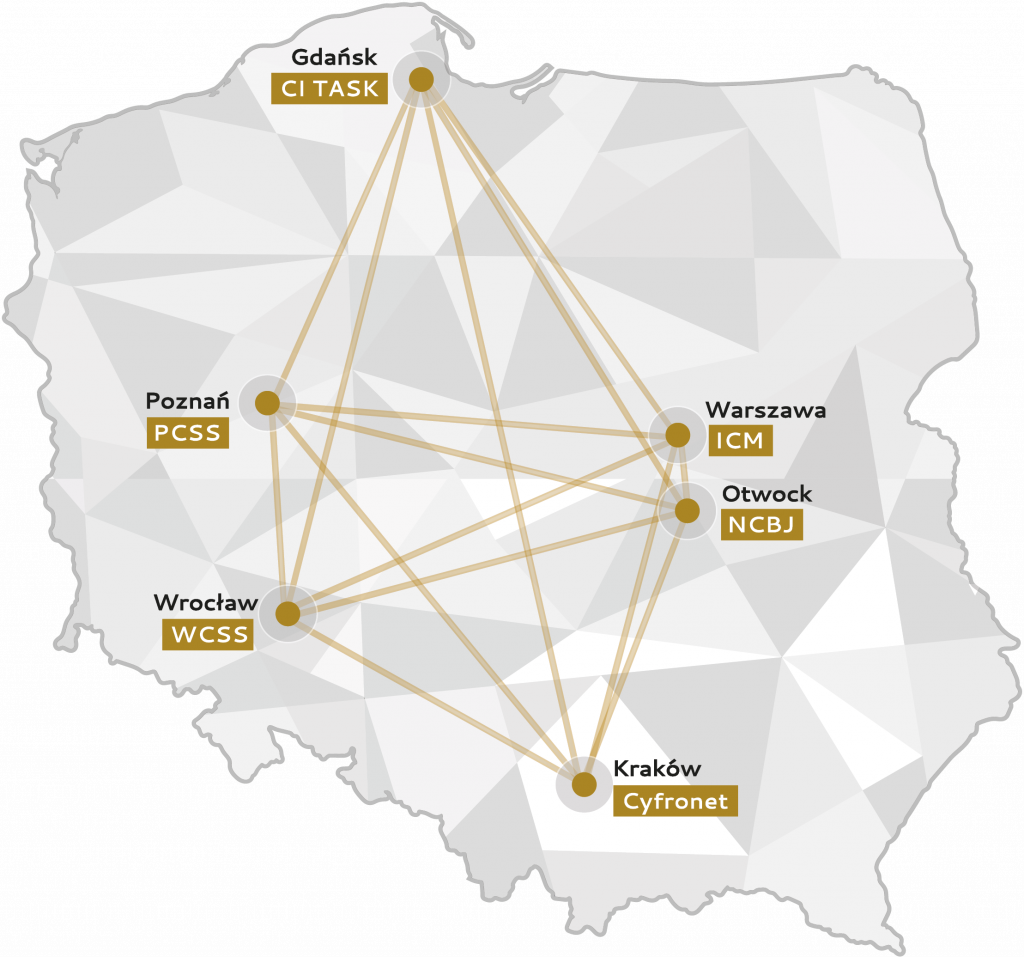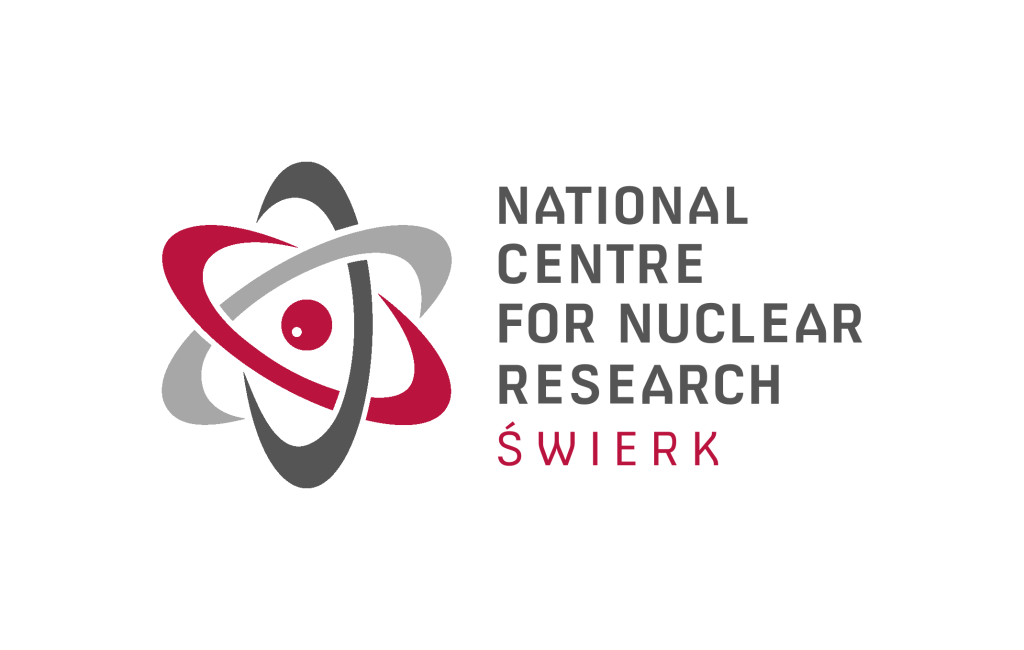The National Competence Centre in
HPC
HPC IN POLAND
HPC (High Performance Computing)
In summary, high-performance computing involves utilising computer systems connected to a single large supercomputer to perform complex and advanced calculations that are impractical on regular computers. High-performance computing, used in weather forecasting, quantum physics, fluid mechanics, molecular biology, and other fields, is made possible by the collaboration of multiple servers within an elaborate system, called a computer cluster or supercomputer. These machines are equipped with hundreds or even thousands of servers, multi-core processors, accelerators, substantial amounts of RAM, and disk space, enabling them to store and rapidly process vast amounts of data.
Supercomputing centres in Poland which are part of the National Competence Centre in HPC

CI TASK – Centre of Informatics
Tricity Academic Supercomputer and networK (Gdańsk)
PCSS – Poznan Supercomputing and Networking Center (Poznań)
ICM –Interdisciplinary Centre for Mathematical and Computational Modelling UW (Warszawa)
NCBJ – National Centre for Nuclear Research (Otwock)
WCSS – Wrocław Centre for Networking and Supercomputing (Wrocław)
EXAMPLES OF PROJECTS COMPLETED THRUTH THE USE OF SUPERCOMPUTERS
- Medicine
- Energetics
- Meteorology
- Aviation
- Physics/CFD
PROJECT: Mortality prediction and pathology detection in chest imaging screening using deep machine learning techniques
PROJECT OBJECTIVE: To demonstrate that with the help of artificial intelligence techniques applied to the analysis of medical images in screening, it is possible to detect pathological changes early and assess the risk of death. The main tasks of the project are the development and validation of AI models that perform the above tasks and the development of explanatory methods for the model results.
PROJECT: Agent modelling for the MOCOS group – Modeling Coronavirus Spread
CEL PROJEKTU: Analysing risk, making forecasts for the next days and weeks, providing recommendations for combating COVID-19. Supporting public institutions in bringing the epidemic to a state of extinction (subcritical), i.e. reducing the scale of reproduction of the virus to a level irrelevant to public safety.
PROJECT: COVID-19 epidemiological model
PROJECT OBJECTIVE: Provide epidemiological forecasts and analysis of the epidemic situation in the country. The results of the research were presented to state institutions responsible for health care, epidemic surveillance, and administrative decisions affecting social life in the country. Forecasts and analyses are formulated on the basis of simulations carried out using software developed at ICM UW in previous years and intensively developed to meet the requirements of the changing epidemic-administrative situation.
PROJECT: Preparation of reference databases of the Direct Numerical Simulations class for the design of new nuclear technologies and nuclear safety applications
PROJECT OBJECTIVE: Generation of two Direct Numerical Simulations (DNS) class reference databases for two physical phenomena occurring in nuclear reactors:
- pressurised thermal shock (PTS)
- mixing of coolant in fuel cassettes.
PROJECT: “Do you know what are you breathing in?” Information and education campaign for cleaner air LIFE – MAPPINGAIR/PL
PROJECT OBJECTIVE: One of the tasks of the project is operational forecasting of air quality at high temporal and spatial resolution (forecast range: 72 h, temporal resolution: 1 h, spatial resolution for Poland domain: 4 km, for 1 km subdomain: 50 m), using WRF-Chem, EMEP and uEMEP forecasting models, and making forecasts operationally available to the public.
PROJECT: Non-commercial and commercial applications of numerical meteorological forecasts
PROJECT OBJECTIVE: Identifying the needs of meteorological forecasts’ users and then commercialising these forecasts by:
a) creation of personalised products dedicated to specific user groups,
b) commercial provision of archived and current forecasts,
c) development of forecast access channels: website and mobile application,
d) the development of forecasts with a view to their application in areas of utility to society and state security.
PROJECT: Numerical aerodynamic and aeroacoustic analysis of flow control methods
PROJECT OBJECTIVE: Improving the aerodynamic and/or aeroacoustic characteristics of streamlined structures using numerical studies employing passive and active flow control methods (e.g.: sheet, bar and fluidic vortex generators and perforated walls).
PROJECT: Electron structure calculations of disordered TiO2 rutile on a vector computer
PROJECT OBJECTIVE: The main objective of the project is to carry out electron structure calculations of rutile (TiO2) on the NEC SX-Aurora TSUBASA vector computer in two variants:
(i) for a system not affected by structural defects and
(ii) for a system containing defects in the form of oxygen vacancies.
An existing implementation of the equation of motion method was used to complete the task.
The specific objective was to adapt the programme to work efficiently on the NEC vector architecture, optimise it, and perform performance and scaling tests on the new version of the programme.
PROJECT: Numerical analysis of vertical axis wind turbines
PROJECT OBJECTIVE: Currently, numerical fluid mechanics methods are a popular tool for aerodynamic studies. The purpose of this project was analysis of the aerodynamic loads of a Darrieus-type rotor andand development and validation of the author’s numerical model for the analysis of rotor aerodynamic performance.
PROJECT: Use of high computing power for design analysis and optimisation of large-scale industrial mixers with consideration of thermal-fluid processes
PROJECT OBJECTIVE: Development of mathematical models of mixing processes and their implementation in commercial and open source numerical software. During the project, the models were validated and ultimately used during the design of the optimised mixers. Design elements directly involved in the mixing process, such as mixing/dispersing discs, anchors and elements supporting the process, were optimised. In addition to the flow processes, both thermal processes resulting from the friction of the mixed products and the heat input from the heating/cooling systems installed in the unit were implemented in the models.
PROJECT: Performance tests of the CIŚ supercomputer in fire safety simulations
PROJECT OBJECTIVE: The analysis of wind-fire events requires considering the simultaneous interaction of wind and the variable development of the fire over time. To obtain statistically valid results, it is necessary to perform dozens of simulations considering different wind directions and speeds. This, in turn, requires significant computational resources and scalable computational fluid dynamics (CFD) models. As part of the tests, actions were planned and carried out to determine the optimal size of the computing unit for CFD simulations of wind and smoke flow in the garage model. These actions allowed for the optimal selection of the number of scenarios, numerical grid size, and the method of simulating thermal radiation.












